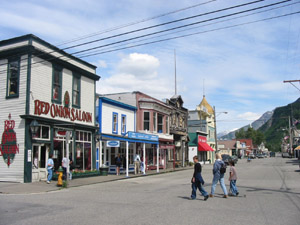
While the town sleeps, three to eight cruise ships arrive. In the morning as many as 8,000 people pack the streets, shops, and cafes. The ships only spend one day in port so by 7:00 p.m. all is quiet again.
Skagway, Alaska. From this small town the overland journey to the Klondike Gold Fields began. Cheryl really wanted to hike the famous Chilcoot Pass Trail. This is the very steep trail taken by thousands of gold seekers in the early 1900's. Even in late June the trail is packed with snow and ice and may require wading through spring run off. The hike takes several days and is not recommended for novice hikers. Maybe next year we'll go. We could write for hours with stories we've learned about the Klondike Gold Rush. If you go to Seattle there is a Klondike Gold Rush National Park Visitor Center in the downtown area near the waterfront.
 |
As you can see, Skagway is a nice, quiet, little town.
But then, I took this picture at night; (at night? you may ask -- we were
here on the Summer Solstice -- the longest day of the year and it didn't
start getting dark until midnight.) During daytime hours it looks
more like Main Street, Disneyland.
While the town sleeps, three to eight cruise ships arrive. In the morning as many as 8,000 people pack the streets, shops, and cafes. The ships only spend one day in port so by 7:00 p.m. all is quiet again. |
On June 21st the locals have a big party celebrating Summer
Solstice. There is a barbecue at the ball field with several bands
that play well into the the dark. Mitch and Max met many of the local
kids and hung out with them the rest of the week while we were in town.
| If you travel by cruise ship it is difficult to see attractions
that take more than one day, go on a glacier tour or other evening events
that extend past 6:00 at night. These big ships come in at night,
unload in the morning, and leave that evening between 5:00 and 8:00 p.m.
We also learned that they have business agreements with certain attractions and transportation services.
|
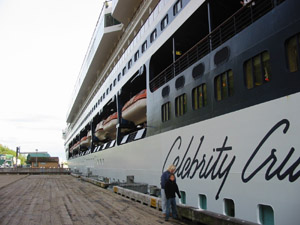 |
What they don't tell you is that the glacier is only ten miles from the center of town and that you can take a bus - round-trip - for less than $10. So, I guess the moral to the story is that if you are planning to go on an Alaskan cruise, get on the Internet and do a little research about the places you will visit. We're sure that the helicopter tour is fun and impressive, but its nice to have all the facts before you start shelling out all that money.
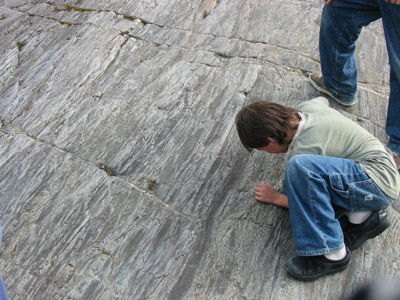 |
This picture was taken at the Mendenhall Glacier. I don't want to sound complacent, (but after spending four months in Alaska,) if you've seen one glacier, you've seen them all. Max was more impressed with the rock. We've heard and seen the scratches in rocks that are made by advancing and retreating glaciers, but these were really dramatic. Not the cracks, but the gouges running from top to bottom where rocks have been scraped along the way. |
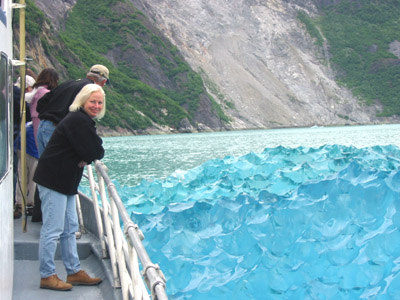 |
A highlight of our Alaskan trip was a boat tour to Tracy Arm Glacier, a few hours out of Juneau. Here's a small iceberg that has recently broken off the glacier. When we took this photo, the iceberg had just rolled over. The ice in the glacier is compressed under high pressure, squeezing out the oxygen. As it floats in the bay it keeps it's blue, low oxygen color, but will soon turn white as the outer surface ice oxidizes, (rusty ice).
|

At times the captain approached close to the glacier but was always on the lookout. He explained how large chunks of ice also break off of the bottom of the glacier a hundred feet below the water. Ice floats, causing these icebergs to shoot to the surface like a missile.
We spent two hours hanging around this glacier and another hour seeing another glacier and some spectacular waterfalls. At one waterfall the captain brought the bow of the boat under the waterfall. Some Explorer Boy Scouts onboard took off their shirts and stood under the icy shower, but our boys were happy to just enjoy the spray.
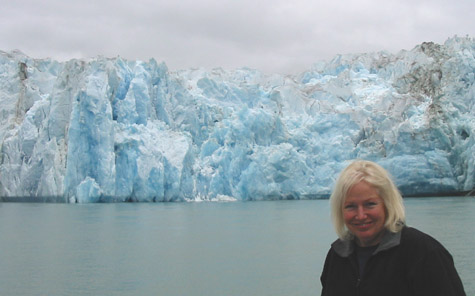 |
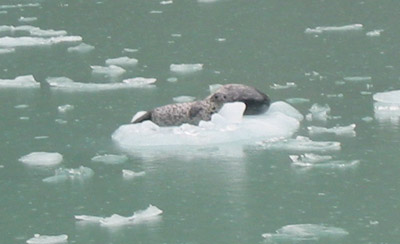 |
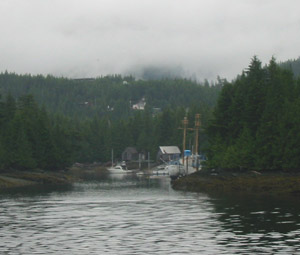 |
Back on the Alaskan ferry, we were able to navigate
passages too small for the big cruise ships. The Inside Passage is sprinkled
with small fishing villages, many of which have no roads. Without roads,
these towns have a personality unlike small towns in the Lower Forty-eight.
We stopped at the small island of Wrangell, population 2479. As far as people we met, this had to be the friendliest, most pleasant place in Alaska. |
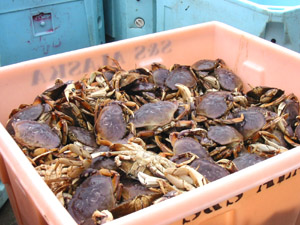 |
We enjoyed visiting with locals. One day we hung
around the fishing docks in Wrangell talking with the fisherman.
We heard some pretty interesting stories.
Like, what do you do if the local fish processor has a full freezer, the next ship to haul the frozen fish to market won't be here until next week, and you arrive at the dock with 1,000 pounds of salmon in your boat's hold. The fellow we talked to said that the local grocery store wouldn't buy his catch; (after all, no one here buys fish from a grocery store.) The best he could get was 25 cents a pound from the crabbers to use as bait. The best they can get for salmon is $1 a pound. |
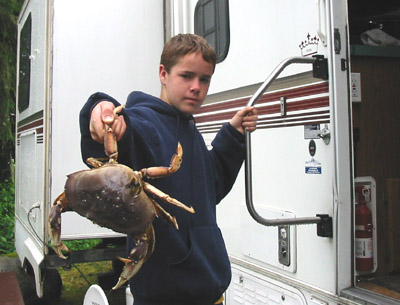 |
We bought 2 big crabs on the dock for $5 and a fisherman
gave us a large salmon off of his boat, (but we insisted he take $10 for
it.)
The town of Wrangle is about 10 blocks long with the marina on one end and the Ferry terminal on the other. We were shopping in one of the two grocery stores when Cheryl said, "they are out of milk." The store manager came from around the corner and said the barge had arrived this morning. |
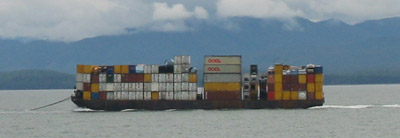 |
He should have milk in the store in about four hours. Here, everything comes and goes by barge. On top of the containers there are cars, trucks, and boats. Later when we drove by the ship yard, we watched a guy swing the door open on a container and drive a Toyota out. Behind the Toyota was a couch and lots of boxes. |
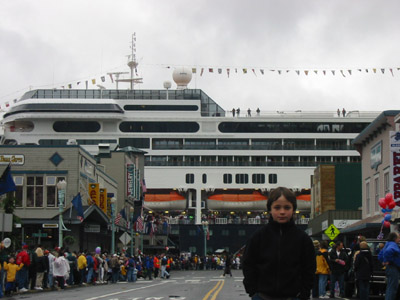 |
Growing up in Seattle, Ed is used to a little rain during
a Fourth of July Parade. This parade was quite similar.
Here, Max is standing on the parade route in downtown Ketchikan with a cruise ship in the background. |
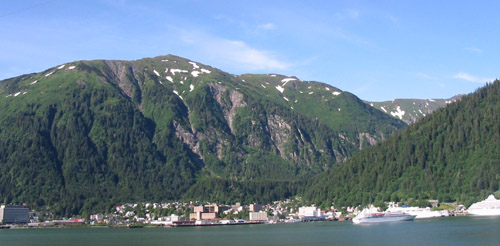 |
We drove across a bridge to an island where we could
take this picture of Ketchikan. It looks like there are three cruise
ships to the right.
One difference we saw between Alaska and the Pacific Northwest is the way the mountains rise high and steep right out of the water. |
We had a great time in Alaska and highly recommend it
to RV'ers. Just give yourself enough time to enjoy it.
|
|
|
|
Next Adventure (Travels with Ikumi) |